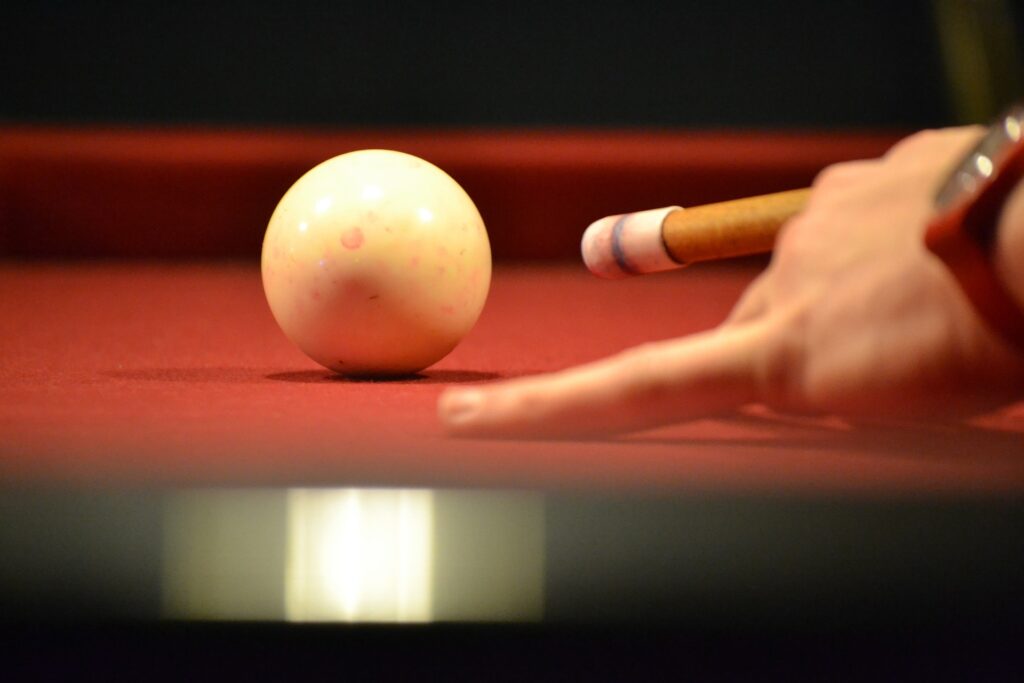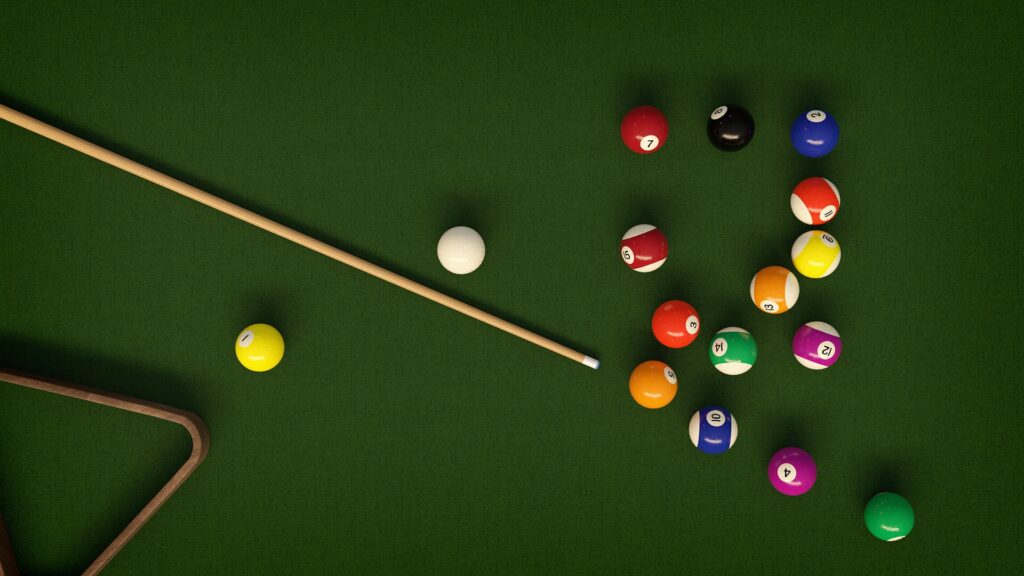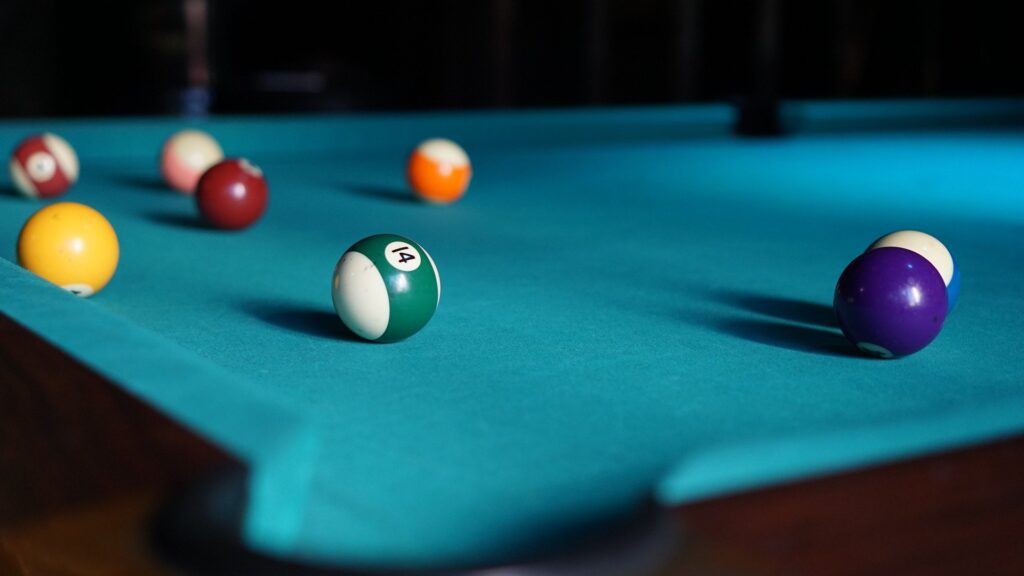As an Amazon Associate we earn from qualifying purchases.
If you just started playing pool, you’ve probably wondered what are pool balls made of? Pool’s history dates back into the 16th century and the materials used to make pool balls have differed throughout pool history. In this article, we’ll delve deep into how pool balls came to be.
What Are Pool Balls Made of?
Today, pool balls are made of polyester or phenolic resin materials. Phenolic resin offers durability while being resistant to scratches and chipping. Popular pool ball manufacturers such as Saluc uses phenolic resin in their pool balls.
Pool balls made of phenolic resin last longer compared to pool balls made from polyester. Phenolic resin contains chemicals that allow for the pool ball to maintain their high polish gloss for a long time. It also creates less friction between the billiard cloth and other billiard balls.

Phenolic resin offers a stabilized material when heat cured properly. The center of the ball is balanced so you get an accurate roll. The heat curing gives the pool ball a vitrified high-density surface that can endure better than pool balls made of polyester.
What Makes a Standard Pool Ball?
Billiard balls have a set of criteria that they need to meet in order to make it to the pool table. These are:
- Density
- Balance
- Diameter tolerance
- Roundness
- Color precision
- Surface polish
- Durability
Pool balls usually take 23 days to make. They undergo processes such as cast, cure, grind, and polish to meet the criteria.
Manufacturers have a tight tolerance for quality. The specifications must be met with state of the art technology and excellent craftsmanship ensuring the quality of the pool balls.
History of How Pool Balls Were Made
Pool has been played as early as the early 1700s. Historians would argue it was in the 1340s but it was a mix of billiards and croquet.
Earliest Recorded Pool Ball
Pool was largely considered a game for French and British nobility. They play indoors with a table using a cue stick to knock pool balls into the table’s pocket.
In the early history of pool, balls consisted of wood. Wood was a resource that wasn’t expensive to produce which gave traction to pool. However, wood wasn’t great for pool balls as it easily chipped or cracked and didn’t have the right balance.
How Colonization Affected Pool Balls
As Europe started their exploration and colonization of Africa and Asia, Europeans also explored exotic materials to use. Among them is ivory which was a high commodity and only the rich owned as a means to display their wealth.
Ivory became the main material for pool balls in 1627. Pool balls were mostly made from the tusks of elephants. It takes one adult elephant to make 8 pool balls so owning a set of pool balls would mean that you were wealthy.

Some pool players like ivory better than wood as they claim it acts more of a ball with ivory. However, ivory can also crack and chip easily. There’s also the problem of the elephant population running out. Ivories would later be discontinued from being used in pool balls.
Pool Balls After Ivory
In 1862, Alexander Parks invented a plastic called Parkesine. However, it did not hold up well against the constant abuse pool balls get from pool. With the problem still at large, a pool company named “Phelan and Collender” offered $10,000 to whoever could find a better alternative to ivory.
In 1869, a man named John Wesley Hyatt invented a plastic known as celluloid. However, this plastic was combustible and flammable which cause pool balls to explode sometimes.
Finally, in 1907, Phelan Leo Baekeland invented a plastic called bakelite. It became the main material used to make pool balls by the mid-1920s.
How Pool Balls are Made Today
In today’s age, manufacturers use phenolic resin for making pool balls. In fact, phenolic resin is just bakelite yet made under more pressure. You may not know this: 85% of pool balls come from one company by the name of Saluc.
You might have noticed that the colors of the pool balls are solid all the way through except for the numbers. Saluc makes the materials under very high pressure for better density and hardness.
Saluc pool balls can withstand 5 tons of pressure. Saluc also claims that their pool balls can last for 40 years or 40,000 impacts. The gloss also doesn’t wear off easily.
Finally, pool balls have different weights. After pool balls are made, they are weighted and sorted to match with other balls to create a balanced set.
What Are the Standard Colors of Pool Balls?
In a pool ball set, you get 15 colored object balls and 1 white cue ball. The colors of the pool balls have their meaning. Each numbered ball has a designated color so that once you get to familiarize the pool balls, you don’t have to look at the ball at an angle to check the number.
You can easily call your shot just by looking at the color. There are also different types of pool balls. They are solids, stripes, and the cue ball. We’ll see what differences they have.
Solids
Solids are balls that are numbered one to eight. People call them solids because they have a solid color except for the small white circle around the number. To help you with pool ball memorization:

- One – yellow
- Two – blue
- Three – red
- Four – purple
- Five – orange
- Six – green
- Seven – burgundy
- Eight – black
9 ball game uses mostly solid pool balls with one stripe ball.
Stripes
You have counterparts for every solid ball except for the eight and they’re called stripes. Stripe balls represent numbers nine to fifteen.
Stripe balls have base colors of white with a colored stripe going around the middle. They also have a white circle around their number.
- Nine – yellow stripe
- Ten – blue stripe
- Eleven – red stripe
- Twelve – purple stripe
- Thirteen – orange stripe
- Fourteen – green stripe
- Fifteen – burgundy stripe
If you find it hard to remember, just add eight to the number of the corresponding color. For example, two is blue so add eight to it and you get ten which also has the color blue but with stripes.
The eight is the only one who doesn’t have a respective stripe color because of the 8 ball pool. The 8 ball pool is a game where you hit either solid or stripe while your opponent hits the opposite. After hitting all balls in the group, the last one you need to pocket is the eight.
Cue Ball
People use the cue ball to strike with their cue stick to pocket the object balls. Cue ball always comes in the color white. Some cue balls contain some red dots that guides you with aiming.
Not all cue balls come in the same size. They’re made different according to the pool table or what games to play.
- Russian pyramid and Kaisa – 2 11/16 inches or 68 mm.
- Carom – 2 7/16 inches or 61.5 mm.
- International Pool – 2 ¼ inches or 57.15 mm.
- British style pool (large) – 2 3/16 inches or 56 mm.
- Snooker – 2 1/15 inches or 52.5 mm.
- British style pool (regular) – 2 inches or 51 mm.
- Miniature pool – 1 ½ inch or 38 mm.
Related Questions
What Are the Best Pool Balls Made Of?
People often wonder why pool ball sets have such a huge difference in prices. It’s all because of the materials used. Pool balls within the low end of the price range use materials such as acrylic or polyester. Pool ball sets within the higher price range use phenolic resin.
Phenolic offers better durability and creates less friction. Phenolic resin balls also have more elasticity and higher resistance to scratch and chip.

What Are Pool Balls Called?
You don’t have to call pool balls in other names. They are called pool balls. However, we have mentioned the classifications of pool balls above. To refresh your mind, you get a total of 16 balls in a full pool ball set.
The white ball is the cue ball while the other colored balls you call them object balls. Each object ball has its own respective number. People call the balls numbered 1 to 8 solids while the balls numbered 9 to 15 are called stripes.
Other people use less common names such as:
- Highs and lows
- Spots and strips
- Bigs and littles
Some people also don’t consider 8 as a solid.
Do Pool Balls Get Old?
Pool balls do wear out. The average pool ball wears out after about a year of use and when its size no longer meets the specification of a pool game. Pool balls degrade with use especially if it gets hit a lot.
Cue balls tend to degrade faster because of being constantly hit by cue tips. If you don’t play pool that often, your pool ball set can last for well over a year.
Your pool balls’ longevity also depends on its quality. As stated before, phenolic resin pool balls last a lot longer than other pool balls.
Why Do Pool Balls Turn Yellow?
Your pool ball turns yellow because of oxidation. It’s the same as rust yet it can be annoying to clean. You can use ball polish to make it white again or back to its original color.
Some people use an acid such as weak baking soda solution or vinegar to bring back their pool balls to their original color. Some people also use bleach or household disinfectant to clean their pool balls.
Conclusion
Pool balls have come a long way from being made out of wood, then into ivory, and some early plastic, until using phenolic resin. Most manufacturers like using phenolic resin because of its durability and longevity.